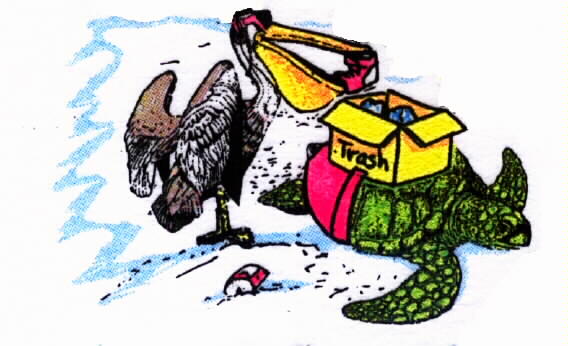| Objective: To define
"marine debris" and to learn the types and amounts of marine debris found
each year in national beach cleanups in the United States.
Activity: Students bring in different trash items and define
"marine debris" through a discussion about these items. Students then categorize
debris and use statistics and graphing to better understand the types and
amounts of marine debris that are found each year.
Vocabulary: Debris, foamed plastic, marine, marine debris, trash
Materials:
· Enough copies o the "1997 Beach
Cleanup Results" handout for each student in the class
· A large box
Subjects: Language arts, mathematics, science
Learning Skills: Analyzing, calculating, classifying, collecting
data, observing
Duration: 40 minutes
Grade level: 4-12
|
Lesson Activities
1. Ask every student to bring in a nonfood piece of trash. Tell students
to be sure that the trash is clean and dry, does not have food stuck to
it and is not sharp. (Note: to prevent accidents, you may wish to tell
students not to bring in glass. Instead, you can bring in a few glass articles
so the discussion of debris will be complete.)
2. Have each student bring his or her piece of trash to the front of
the room, display it to the class, and put it in a large box. Ask the students
what these items have in common. Through this discussion, identify the
characteristics of "trash" and develop a definition. Write the definition
on the board. Then ask students to think of synonyms for "trash" and help
them come up with the term "debris". List all of the synonyms on the board.
3. Now that "debris" as been defined, ask students what "marine" means.
Write the definition on the board. Ask the students to list synonyms for
marine and write them on the board.
4. Then combine the terms and discuss the meaning of "marine debris".
Write this definition on the board. Use the lists of synonyms to come up
with other terms that describe the concept of "marine debris" (such as
"sea trash" and ocean waste").
5. Take a piece of trash out of the box one by one and ask students
to classify the type of debris they are (plastic, glass, metal, etc.).
6. Print out and distribute the "1997
Tampa Bay Beach Cleanup Results" handouts to the class. Inform the
students that the Center for Marine Conservation (CMC) sponsors beach cleanup
campaigns all over the country. Explain that volunteers record the items
they find when they clean up beaches and send this information to CMC,
which complies these lists every year.
7. Ask the students to use the "1997 Beach Cleanup Results" handout
to make a bar graph comparing the quantities of the different types of
debris (plastic, glass, metal, etc.) collected in the cleanup. Have the
students add the total number of plastic items, the total number of glass
items, etc., to complete the handout. (Note:
If students have difficulty adding such a long list of numbers, you can
give them the totals: plastic items, glass items, rubber items, metal items,
paper items, wood items, and cloth items.)
8. Next, have students label the horizontal
axis of the bar graph as "category of marine debris" and write the different
categories under the horizontal axis "number of items collected" and mark
the axis from 0 to 3,000,000. Finally, tell the students to use the totals
from the "1997 Beach Cleanup Results" handout to complete the bar graph.
(Note: As a class, you can create a three-dimensional bulletin board to
display the bar graph. After drawing the bar graph on a large piece of
paper, tack the paper to the bulletin board. Then glue or tape examples
of the types of trash represented by the bar graph around it.)
9. Hand out 1998 Tampa Bay Cleanup Stats
sheet. Ask students to calculate the percentage of total volunteers from
each county, number of volunteers, pounds of debris collected, and number
of shoreline miles.
|

